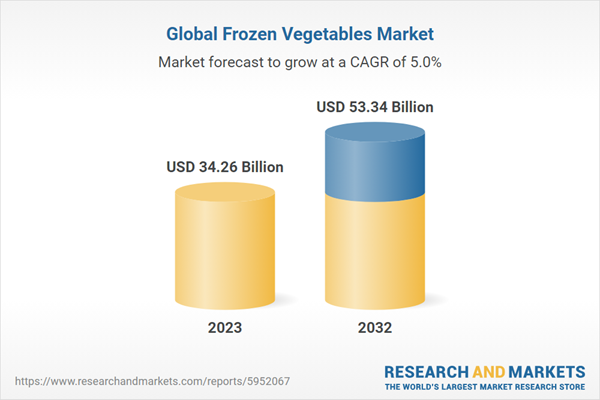Frozen vegetables have an extended shelf existence, making them handy for lengthy-term storage and use. Freezing preserves essential nutrients like carotenes, that are crucial for vitamin A synthesis in the body. Many meals manufacturers employ freezing strategies to save meals waste, cater to the needs of a developing population, and preserve competitiveness and profitability within the foods industry, with the processed food sector rapidly evolving and accelerated expenditure on meals objects, particularly packaged vegetables, marketplace increase is anticipated inside the foreseeable period. Additionally, ongoing advancements in product innovation and attractive packaging further stimulate demand for processed greens vegetable, mainly in rising markets.
Frozen Vegetables Market Surveys
In February 2024, Nortera, a North American chief in vegetable processing, launched the consequences of a survey on Canadians' relationship with frozen veggies. The survey revealed that 85% of Canadians enjoyed those handy, nutritious alternatives during the last year, and almost 1/2 (48%) say they buy them as a minimum as soon as a month.A November 2022 survey by the American Frozen Food Institute (AFFI) found that over a one-fourth of customers have accelerated their purchases of frozen fruits and veggies in comparison to 3 years in the past. Nearly all-American households, 94 percent, now purchase frozen produce.
In March 2024, surveys through Acosta and Advantage found that customers increasingly prioritize three factors while making frozen meal purchases: fee, convenience, and health. Acosta found that 67% of consumers perceive frozen meals as imparting better value, particularly in categories like vegetables, fruit, meat, fish, and pizza. Additionally, most customers keep frozen food handy, especially for those who cannot cook. However, the most effective 25% agree that frozen dinners, snacks, and entrees are as nutritious as homemade options. Consumer packaged goods (CPG) organizations focus on innovating more healthy products and supplying clean messaging to train clients approximately more healthy frozen meal selections. A Rabobank study indicates that consumer demand has tripled frozen sweet potato imports from the USA to the EU within the past four years.
Europe Frozen Vegetables Market
Europe is a key market for frozen vegetables because of busy lifestyles and a demand for inexpensive, flavorful, and healthy options. Frozen greens provide versatility, like berries for smoothies and kale for crisps. Rising earnings and nutritional shifts in the direction of greens pressure the market, with possibilities in Germany, France, Belgium, Italy, and the Netherlands. Awareness of frozen vegetables' nutritional value is rising, mainly among younger consumers. In July 2023, Actual Veggies improved its plant based offerings with Black Bean and Super Greens Veggie Burgers at select Whole Foods Market stores.China Frozen Vegetables Market
China frozen vegetables industry has experienced a speedy increase, driven by adjustments in consumer dietary alternatives. Positioned strategically, China is poised to meet the increasing demand for convenient packaged frozen meals that require minimum training or are prepared to devour. Growth opportunities abound across diverse sectors, which include education, tourism, and fast food. With rising disposable income and urbanization, China has turned out to be a subnational market for frozen vegetables products. Despite reduced tariffs on imports, the prices of multinational brands continue to be excessive. Leading companies are directing investments into large-scale centers and garage infrastructure, specializing in cold logistics and premium components, to propel the industry's enlargement in China similarly.Frozen Vegetables Market Company Analysis
General Mills Inc., Conagra Brands, Hormel Foods, Unilever PLC, The Kraft Heinz Company, Nomad Foods Ltd, B&G Foods Inc., and Greenyard are prominent players in the Frozen vegetable market.Frozen Vegetables Industry Mergers & Acquisitions and Collaborations
- In July 2023, Capstone Partners guided frozen pasta manufacturer Mama Rosie's in its acquisition with the aid of Seviroli Foods, supported by Mill Point Capital.
- In April 2023, Nestlé and private equity firm PAI Partners collaborated to establish a joint mission specializing in Nestlé's Frozen Pizza commercial enterprise in Europe.
- In March 2024, 80 Acres Farms plans to expand its salad package services and internally expand dressings sourced from precision-managed farms.
- In February 2024, US frozen meal businesses Twin City Foods and Smith Frozen Foods signed a nonbinding settlement to merge into TCF Holdings, Inc.
Frozen Vegetables Company News
1. In March 2024, BigBasket launched a new frozen food emblem known as Precia in a strategic partnership with famed chef Sanjeev Kapoor.2. In January 2024, Prime Fresh Limited partnered with ITC Limited to decorate our fruits, greens, and frozen foods. This collaboration makes a specialty of strengthening both organizations' distribution, sales, and marketing preparations.
3. In February 2023, Lamb Weston Holdings, Inc. acquired its European joint project with Meijer Frozen Foods B.V.
4. In April 2023, Bimbo Bakeries USA delivered a new variety of frozen treats stimulated by its renowned Entenmann's baked goods.
5. In May 2022, B&G Foods Inc. bought Growers Express, LLC's frozen vegetable manufacturing operations, which produce giant riced veggies and giant veggie spirals. The deal accommodates stock, devices, a sublease in Yuma, Arizona, and a warehouse lease in San Luis, Arizona. About a hundred and fifty-five employees will shift to B&G Foods.
6. In September 2023, Kraft Heinz unveiled 360CRISPTM, a progressive platform that guarantees microwave-cooked food achieves stove-like crispiness. The debut product under this platform is LUNCHABLES® Grilled Cheeses. By the end of 2024, Kraft Heinz seeks to introduce 5 additional products across 4 present manufacturers.
Product - Frozen Vegetables Market breakup into 8 parts
1. Corn2. Asparagus
3. Spinach
4. Green Peas
5. Broccoli
6. Mushroom
7. Green Beans
8. Others
End User - Frozen Vegetables Market breakup into 2 parts
1. Food Service Industry2. Retail Customers
Distribution Channel - Frozen Vegetables Market into 3 parts
1. Discounters2. Supermarket/Hypermarket
3. Others
Countries - Frozen Vegetables Market into 25 viewpoints
1. North America1.1 United States
1.2 Canada
2. Europe
2.1 France
2.2 Germany
2.3 Italy
2.4 Spain
2.5 United Kingdom
2.6 Belgium
2.7 Netherland
2.8 Turkey
3. Asia Pacific
3.1 China
3.2 Japan
3.3 India
3.4 South Korea
3.5 Thailand
3.6 Malaysia
3.7 Indonesia
3.8 Australia
3.9 New Zealand
4. Latin America
4.1 Brazil
4.2 Mexico
4.3 Argentina
5. Middle East & Africa
5.1 Saudi Arabia
5.2 UAE
5.3 South Africa
All the key players have been covered from 3 viewpoints:
- Overview
- Recent Development
- Revenue Analysis
Company Analysis:
1. General Mills Inc.2. Conagra Brands
3. Hormel Foods
4. Unilever PLC
5. The Kraft Heinz Company
6. Nomad Foods Ltd
7. B&G Foods, Inc.
8. Greenyard
Table of Contents
Companies Mentioned
- General Mills Inc.
- Conagra Brands
- Hormel Foods
- Unilever PLC
- The Kraft Heinz Company
- Nomad Foods Ltd
- B&G Foods, Inc.
- Greenyard
Methodology
In this report, for analyzing the future trends for the studied market during the forecast period, the publisher has incorporated rigorous statistical and econometric methods, further scrutinized by secondary, primary sources and by in-house experts, supported through their extensive data intelligence repository. The market is studied holistically from both demand and supply-side perspectives. This is carried out to analyze both end-user and producer behavior patterns, in the review period, which affects price, demand and consumption trends. As the study demands to analyze the long-term nature of the market, the identification of factors influencing the market is based on the fundamentality of the study market.
Through secondary and primary researches, which largely include interviews with industry participants, reliable statistics, and regional intelligence, are identified and are transformed to quantitative data through data extraction, and further applied for inferential purposes. The publisher's in-house industry experts play an instrumental role in designing analytic tools and models, tailored to the requirements of a particular industry segment. These analytical tools and models sanitize the data & statistics and enhance the accuracy of their recommendations and advice.
Primary Research
The primary purpose of this phase is to extract qualitative information regarding the market from the key industry leaders. The primary research efforts include reaching out to participants through mail, tele-conversations, referrals, professional networks, and face-to-face interactions. The publisher also established professional corporate relations with various companies that allow us greater flexibility for reaching out to industry participants and commentators for interviews and discussions, fulfilling the following functions:
- Validates and improves the data quality and strengthens research proceeds
- Further develop the analyst team’s market understanding and expertise
- Supplies authentic information about market size, share, growth, and forecast
The researcher's primary research interview and discussion panels are typically composed of the most experienced industry members. These participants include, however, are not limited to:
- Chief executives and VPs of leading corporations specific to the industry
- Product and sales managers or country heads; channel partners and top level distributors; banking, investment, and valuation experts
- Key opinion leaders (KOLs)
Secondary Research
The publisher refers to a broad array of industry sources for their secondary research, which typically includes, however, is not limited to:
- Company SEC filings, annual reports, company websites, broker & financial reports, and investor presentations for competitive scenario and shape of the industry
- Patent and regulatory databases for understanding of technical & legal developments
- Scientific and technical writings for product information and related preemptions
- Regional government and statistical databases for macro analysis
- Authentic new articles, webcasts, and other related releases for market evaluation
- Internal and external proprietary databases, key market indicators, and relevant press releases for market estimates and forecasts

LOADING...
Table Information
| Report Attribute | Details |
|---|---|
| No. of Pages | 215 |
| Published | April 2024 |
| Forecast Period | 2023 - 2032 |
| Estimated Market Value ( USD | $ 34.26 Billion |
| Forecasted Market Value ( USD | $ 53.34 Billion |
| Compound Annual Growth Rate | 5.0% |
| Regions Covered | Global |
| No. of Companies Mentioned | 8 |









